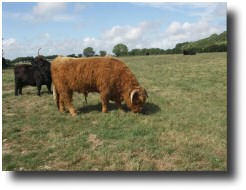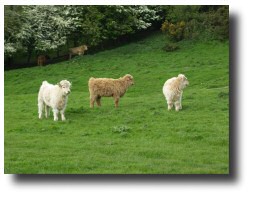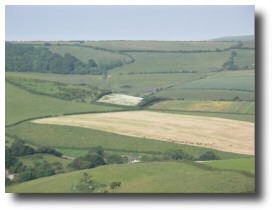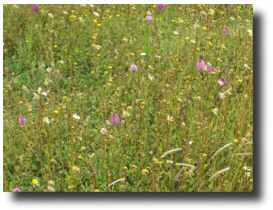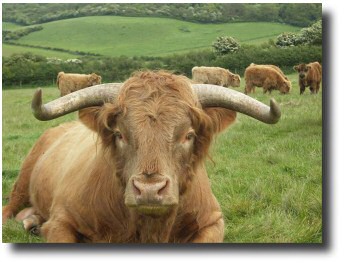You can do it too!Although Wight Conservation is a costly and hugely ambitious project, most householders can do proportionately much more for conservation at no cost to themselves and even at a saving at their own homes.
Our home base in Hampshire is but one example. Within our 22 acres, which embrace the house, garden, a range of traditional old farm buildings,a small broadleaved wood and horse paddocks, are to be found fox, badger, hare, bat, rabbit, roe deer, hedgehog, assorted mice, grey squirrel and vole. All breed there. The thriving bird population includes house martin, sparrow, song thrush, skylark, grey partridge, lesser spotted woodpecker, yellow hammer, kestrel, sparrow hawk, barn owl, and little owl all roosting or breeding. Buzzards and red kites are seen foraging. We have many of the normal species of garden butterflies, although fewer than some years ago. We also have frogs! There is a diversity of flora - cowslip, broom rape, primrose, pyramidal orchid, scabious, nettle-leaved bell flower and other chalk downland species. Snow drops in abundance.
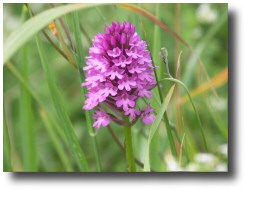 None of our wildlife is artificially encouraged. We leave it all to nature, encouraged by our management practices. Doors and windows in the outbuildings are left open allowing nesting birds to enter and leave at will.& When we top our fields we avoid the cowslips and broomrape and leave unmown edges. Most important of all, we leave a large puddle outside the stables permanently full of water. This is a welcome and necessary source of water for birds and invertebrates. To leave the house martins undisturbed, we carry out no maintenance to the soffit boards during the summer months. The loft is left quiet because of a nesting little owl. Twice this year a little owl descended down the chimney into our lounge! When over, the wildflowers are left for many months to shed their seeds. In the fields we cut around the flowers, also allowing them to shed, but unfortunately deer have found cowslips to be attractive grazing. Dead wood, both standing and fallen, is left to act as a habitat for invertebrates, bats and birds. What we do not do is keep cats, spread chemicals on our lawns or flower beds, or use pesticides and slug pellets. This year there has been no chemical on the fields. You can do it too! Our approach can be so easily replicated by most householders. It costs us nothing. Indeed, it saves us spending on tractor fuel and chemicals. Concerns, however, remain. This year we have only 22 house martin nests compared to a previous peak of 35. Fewer house martins returned from their winter migration, and most left us early in the second week of August. There are fewer insects and over the last two years there has been an almost total lack of wasps. Although hedgehogs live in the garden, we have seen no dead ones on the roads. This has nothing to do with our neighbouring farmers. It is part of a general trend. Raptors always thrill me but the kestrels and the sparrow hawks have been lethal for our garden birds. We used to have a bird table, but no more since it provided a good target area for sparrow hawks. A kestrel flies into the house creeper, ravaging the nests. It is no respecter of buildings; it flies into the outbuildings and takes the parenting birds, leaving the young to starve to death. A kestrel flew in through the conservatory windows to kill a robin which had strayed in. When picking it up, because of its murderous impact upon all our song birds, I was tempted to knock it on the head. It is, however, a protected species and I had to let it go. It flew from my hands as I put it out of the window.
VisitorsWe welcomed many visitors. In June we were one of the two Island farms which participated in "Farm
We showed them the downland restoration at Idlecombe, the wild flora at Wroxall Manor Farm, and the coppicing and other woodland management at Chillingwood. They were particularly complimentary, and David and Henry were thrilled when they discovered a bee orchid in a set-aside field.
In July, together with the Isle of Wight Natural History & Archaeological Society, we organised an evening walk in Rowlands Wood and Chillingwood. The Isle of Wight Point-to-Point Committee organised a subscription dinner in our farm buildings at Wroxall Cross. Jo Ewell catered for 80 guests with unlimited wine and the National Hunt trainer, David Gandolfo, was the speaker. The barns lend themselves beautifully to such an event and the whole evening went with a great buzz. Poisonous WeedsA major problem throughout much of the UK this year has been the enormous increase in poisonous weeds. We were not immune to this and lost a good bull calf from deadly nightshade poisoning. Ragwort has been most prolific. Officially classified as an injurious weed, it is illegal to permit it to spread to other farms. Each plant produces thousands of seeds which can float in the air and cover many miles before settling. Local Authorities have been notably poor at controlling the weed and several farmers, including national charities, have allowed it to develop and spread.
Controlling it is controversial because it is a good habitat for many species, including the Cinnabar moth caterpillar. All things in moderation, however, and if it is allowed to continue uncontrolled it can soon colonise a field, destroying its quality for grazing purposes. It is poisonous to horses and cattle. The damage is accumulative over several weeks or years, but it leads to weight loss, colic, loss of appetite, poor doing, compulsive wondering, staggering, lung and liver damage, jaundice and eventually death. Despite its wildlife value, we are legally bound to control it. Such was the problem this year, however, that in June we had to abandon 130 acres of badly needed grazing and concentrate on eradicating the weed. Despite having three separate gangs, each out for several weeks, we still failed to get on top of the problem. It is at its worst on Mottistone and Idlecombe Downs.
Hemlock is also on the increase. A tall elegant plant from the parsley family, it is found largely in field edges and hedges. It is poisonous to both animals and humans. It was used by the Greeks to kill Socrates and is especially tempting to children who can use its hollow stems as pee-shooters. It takes only a small amount to cause a problem which occurs within between two hours and two days. It begins with nervous signs, paralysis, convulsions, colic and then death. Fortunately, it is not as abundant as ragwort and we are more able to control it. The worry is how it fares in future years.
Thistle seeds also spread as they are blown for miles in the air. They too have been a major problem but although injurious to pasture, they do not have the same poisonous effect. We have tried to control them alongside the ragwort but similarly it has been somewhat of a losing battle. One can only worry for the future.
Wildlife SurveysOur invertebrate and bird surveys have continued apace. The Watsons on Rew Farm Graham Sparshott, who is surveying some property elsewhere on the Island, was thrilled to notice a pair of nesting hobbies who have successfully produced two juveniles.
Highland Cattle
The calves are coming along well and we have some very good looking young bulls and heifers. The dry weather, however, caused us problems and there has been a great shortage of grazing. In some fields the grass completely frizzled up. The cattle do not like being out in the sun and consequently seek as much shade as possible. The result is that as they shelter they do not go out and graze. Hence they can lose condition and in some cases become stressed. Consequently, and unusually, we had to feed them supplements and also some hay. The hay-making went well. Frustrated at relying upon contractors where one has to queue for their attention and often miss the weather breaks, this year we invested in our own tackle to give us complete independence. We were able to make the hay when we wanted and, without problems, had it all mown, turned, bailed and carted during the good weather. It was not of last year’s quality, however, but this was offset by putting a larger acreage down to hay.
Set-AsideOur set-aside has been a great success this year. Set-aside is arable or pasture land which farmers are obliged by DEFRA to take out of production. It can either be annual or permanent. At Wroxall Manor Farm we have two permanent set-aside fields – Machine Gun Nest and Woods. The successful impact of set-aside upon wildlife is to be seen. Machine Gun Nest hosted flora which would otherwise have been grazed but the sensational results were at Woods. This field is on the side of a chalk down with only a very thin layer of top soil. Because of the previous intensive arable farming, it is now poor land for grazing which is allowed between September and January. Its wild flora, however, has been sensational. Densely covered by oxeye daisies in June, this 10-acre field was a blaze of white flower which could be seen from miles away. Once the daisies died off, however, it became a valuable habitat for pyramid orchids which have multiplied in a short space of time and are now numbered in their thousands. The bee orchid is also found there.
Previous Months: September October November December January February March April May | ||||||||||||||||||||||
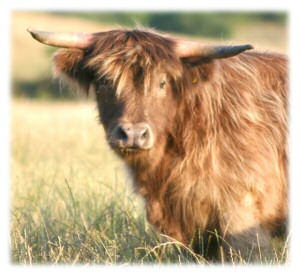
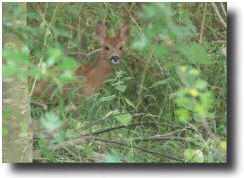
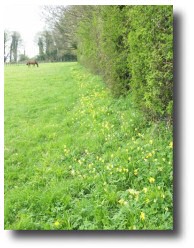
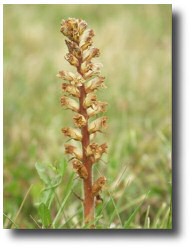
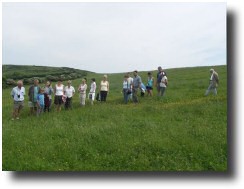 Sunday". In all, nationwide, over 400 farms took part. It was
promoted by the charity LEAF (Linking Environment and Farms). The NFU arranged publicity in the local press and we distributed leaflets. We organised morning and afternoon walks at Wroxall Cross Farm and an afternoon walk up to Mottistone Down. In the evening we walked through Wroxall Copse, an ancient woodland mentioned in the Domesday Book. The Wroxall walks were the most successful and over 50 people in all attended. They were of all ages and from all walks of life. We showed them the Highland cattle, some of the conservation work and how the two activities inter-relate. They were all interested in what we had to show them.
Sunday". In all, nationwide, over 400 farms took part. It was
promoted by the charity LEAF (Linking Environment and Farms). The NFU arranged publicity in the local press and we distributed leaflets. We organised morning and afternoon walks at Wroxall Cross Farm and an afternoon walk up to Mottistone Down. In the evening we walked through Wroxall Copse, an ancient woodland mentioned in the Domesday Book. The Wroxall walks were the most successful and over 50 people in all attended. They were of all ages and from all walks of life. We showed them the Highland cattle, some of the conservation work and how the two activities inter-relate. They were all interested in what we had to show them. We were greatly honoured during the month by a special visit from four well known and high powered mainland conservationists.
The day was organized by Merrick Denton-Thompson, a committed environmentalist employed by the Hampshire County Council, and a Director Designate of Natural England. The other guests were Henry Edmunds, owner of the nationally famous 3,500-acre organic
We were greatly honoured during the month by a special visit from four well known and high powered mainland conservationists.
The day was organized by Merrick Denton-Thompson, a committed environmentalist employed by the Hampshire County Council, and a Director Designate of Natural England. The other guests were Henry Edmunds, owner of the nationally famous 3,500-acre organic
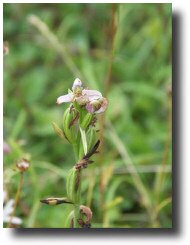 Childerton estate, David Uren who farms near Portsmouth and was a previous winner of the national
Silver Lapwing Award for farmland conservation, and Sir Richard Pelly Bt, owner of the Preshaw Estate
where he is increasingly introducing conservation practices.
Childerton estate, David Uren who farms near Portsmouth and was a previous winner of the national
Silver Lapwing Award for farmland conservation, and Sir Richard Pelly Bt, owner of the Preshaw Estate
where he is increasingly introducing conservation practices.
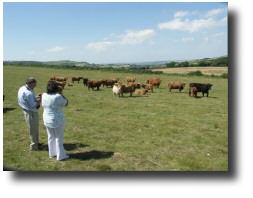 The next day I entertained David and Sheila Baigent, retired farmers from near Alton. David is from an old established Hampshire farming family and Sheila Baigent (nee Barnes), whom I knew in my childhood, used to represent England in equestrian
events. They were really appreciative. It was a great honour that they had bid £600 for
the day at a RABI charity auction near Petersfield.
The next day I entertained David and Sheila Baigent, retired farmers from near Alton. David is from an old established Hampshire farming family and Sheila Baigent (nee Barnes), whom I knew in my childhood, used to represent England in equestrian
events. They were really appreciative. It was a great honour that they had bid £600 for
the day at a RABI charity auction near Petersfield. It was led by Dr Colin Pope, the Society’s President and the County Ecologist.
Colin is a great supporter of Wight Conservation and
we are always greatly indebted to him for giving us his
time and advice. Indeed, the whole Island is lucky to
have him with his enthusiasm, knowledge and the expertise.
Graham Sparshott, the ornithologist surveying Rowlands
Wood, was there to point out different species and interpret the bird song.
It was led by Dr Colin Pope, the Society’s President and the County Ecologist.
Colin is a great supporter of Wight Conservation and
we are always greatly indebted to him for giving us his
time and advice. Indeed, the whole Island is lucky to
have him with his enthusiasm, knowledge and the expertise.
Graham Sparshott, the ornithologist surveying Rowlands
Wood, was there to point out different species and interpret the bird song. 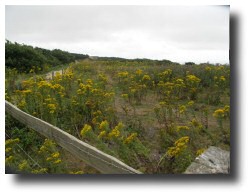
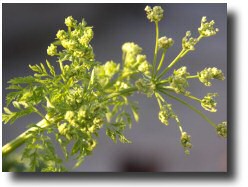
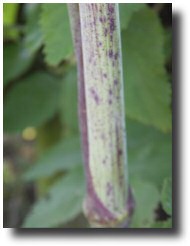
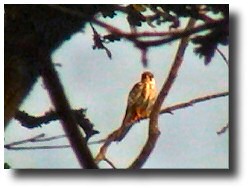 continue to do sterling work. In the two months, they identified 8 extra bird species, making 43 in all, of which 3 are on the Red List. They also make invaluable observations on our other wildlife.
continue to do sterling work. In the two months, they identified 8 extra bird species, making 43 in all, of which 3 are on the Red List. They also make invaluable observations on our other wildlife.